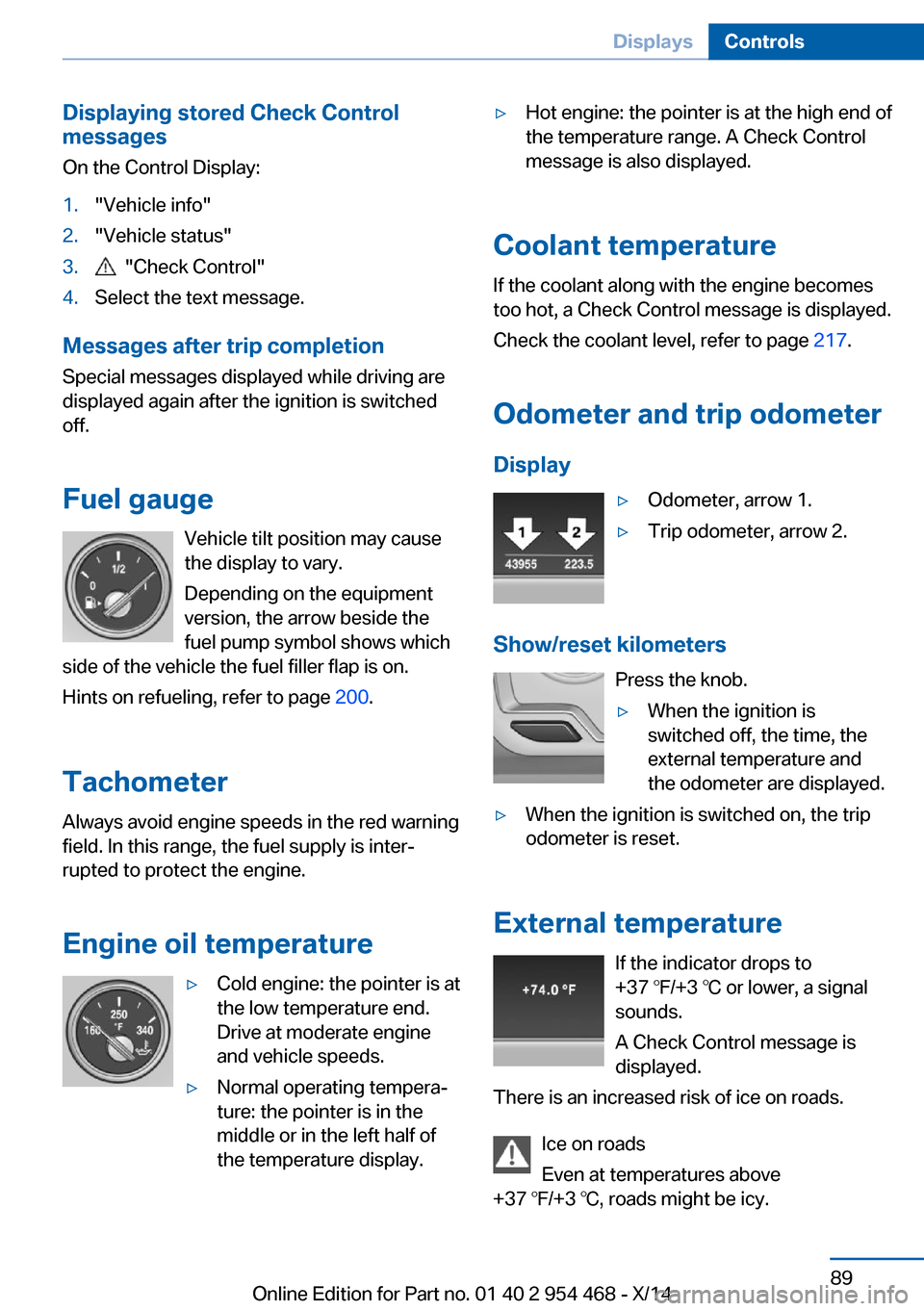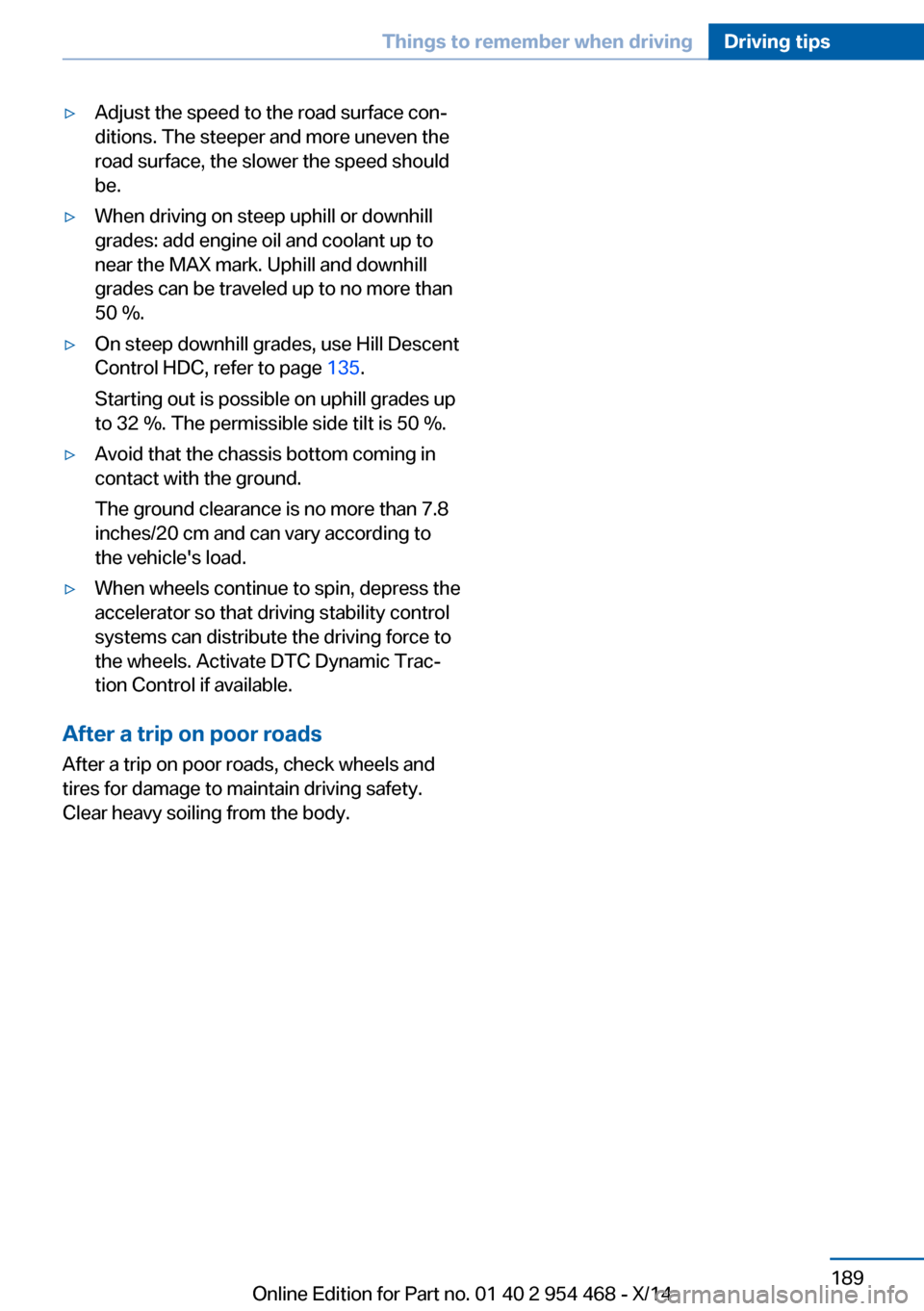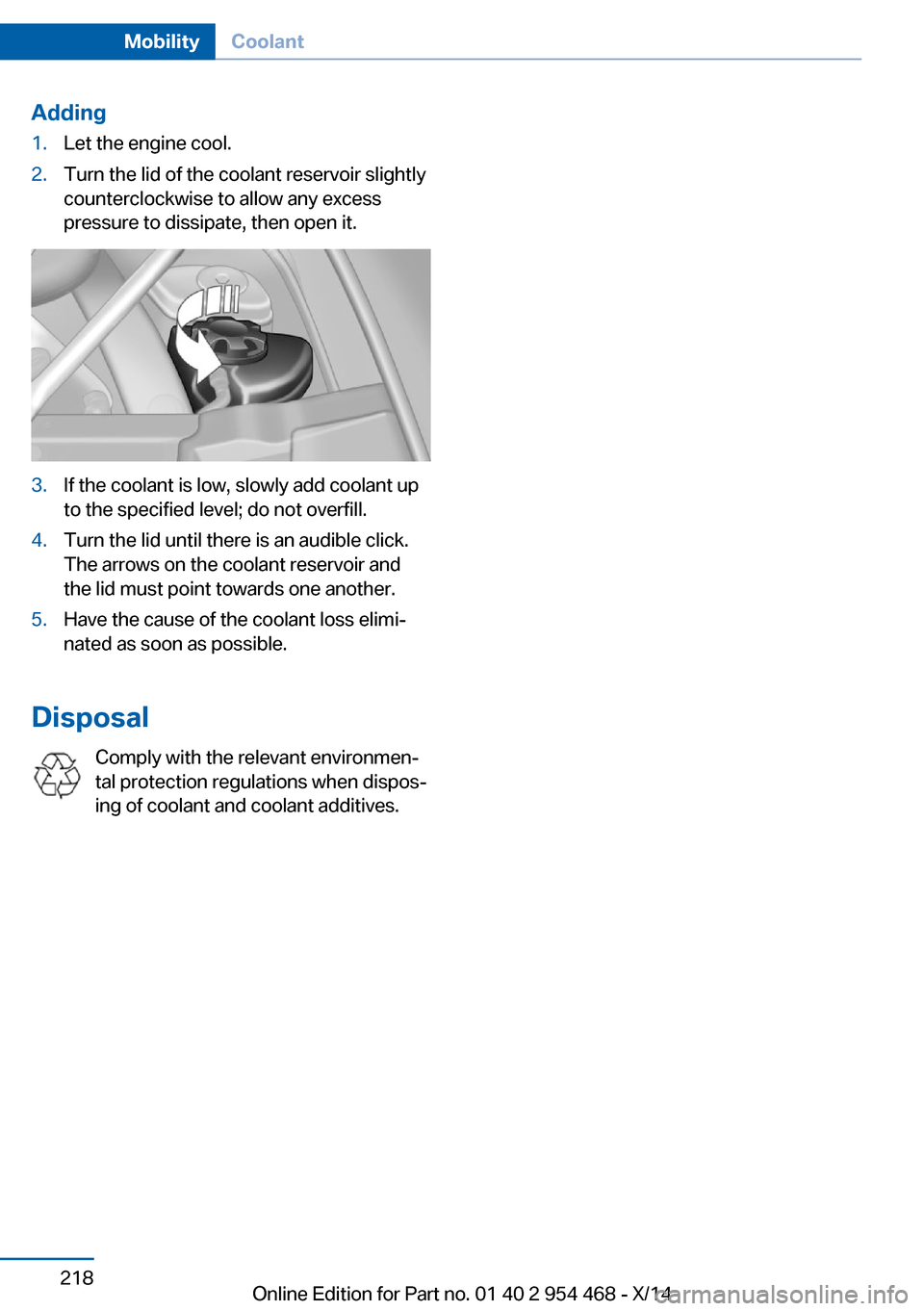2014 BMW X6 coolant
[x] Cancel search: coolantPage 9 of 259

ContentsThe fastest way to find information on a partic‐
ular topic or item is by using the index, refer to
page 244.6Notes
At a glance
14Cockpit18iDrive26Voice activation system29Integrated Owner's Manual in the vehicle
Controls
34Opening and closing51Adjusting62Transporting children safely67Driving81Displays99Lights104Safety132Driving stability control systems140Driving comfort162Climate control169Interior equipment178Storage compartments
Driving tips
186Things to remember when driving190Loading193Saving fuelMobility200Refueling202Fuel204Wheels and tires212Engine compartment214Engine oil217Coolant219Maintenance221Replacing components229Breakdown assistance234Care
Reference
240Technical data244Everything from A to Z
Online Edition for Part no. 01 40 2 954 468 - X/14
Page 93 of 259

Displaying stored Check Control
messages
On the Control Display:1."Vehicle info"2."Vehicle status"3. "Check Control"4.Select the text message.
Messages after trip completion Special messages displayed while driving are
displayed again after the ignition is switched
off.
Fuel gauge Vehicle tilt position may cause
the display to vary.
Depending on the equipment
version, the arrow beside the
fuel pump symbol shows which
side of the vehicle the fuel filler flap is on.
Hints on refueling, refer to page 200.
Tachometer Always avoid engine speeds in the red warning
field. In this range, the fuel supply is inter‐
rupted to protect the engine.
Engine oil temperature
▷Cold engine: the pointer is at
the low temperature end.
Drive at moderate engine
and vehicle speeds.▷Normal operating tempera‐
ture: the pointer is in the
middle or in the left half of
the temperature display.▷Hot engine: the pointer is at the high end of
the temperature range. A Check Control
message is also displayed.
Coolant temperature
If the coolant along with the engine becomes
too hot, a Check Control message is displayed.
Check the coolant level, refer to page 217.
Odometer and trip odometer Display
▷Odometer, arrow 1.▷Trip odometer, arrow 2.
Show/reset kilometers Press the knob.
▷When the ignition is
switched off, the time, the
external temperature and
the odometer are displayed.▷When the ignition is switched on, the trip
odometer is reset.
External temperature
If the indicator drops to
+37 ℉/+3 ℃ or lower, a signal
sounds.
A Check Control message is displayed.
There is an increased risk of ice on roads.
Ice on roads
Even at temperatures above
+37 ℉/+3 ℃, roads might be icy.
Seite 89DisplaysControls89
Online Edition for Part no. 01 40 2 954 468 - X/14
Page 193 of 259

▷Adjust the speed to the road surface con‐
ditions. The steeper and more uneven the
road surface, the slower the speed should
be.▷When driving on steep uphill or downhill
grades: add engine oil and coolant up to
near the MAX mark. Uphill and downhill
grades can be traveled up to no more than
50 %.▷On steep downhill grades, use Hill Descent
Control HDC, refer to page 135.
Starting out is possible on uphill grades up
to 32 %. The permissible side tilt is 50 %.▷Avoid that the chassis bottom coming in
contact with the ground.
The ground clearance is no more than 7.8
inches/20 cm and can vary according to
the vehicle's load.▷When wheels continue to spin, depress the
accelerator so that driving stability control
systems can distribute the driving force to
the wheels. Activate DTC Dynamic Trac‐
tion Control if available.
After a trip on poor roads
After a trip on poor roads, check wheels and
tires for damage to maintain driving safety.
Clear heavy soiling from the body.
Seite 189Things to remember when drivingDriving tips189
Online Edition for Part no. 01 40 2 954 468 - X/14
Page 216 of 259

Engine compartmentVehicle features and optionsThis chapter describes all standard, country-
specific and optional features offered with the
series. It also describes features that are notnecessarily available in your car, e. g., due to
the selected options or country versions. This
also applies to safety-related functions and
systems.
Important features in the engine compartment
1Washer fluid reservoir2Vehicle identification number3Jump-starting, positive battery terminal4Coolant reservoir5Jump-starting, negative battery terminal6Oil filler neck7Diesel engine:
Container for reducing agentHood
Opening the hood Working in the engine compartment
Never attempt to perform any service or
repair operations on your vehicle without the necessary professional technical training.If you are unfamiliar with the statutory guide‐
lines, have any work on the vehicle performed
only by a service center.
If work is not carried out properly, there is a
danger of subsequent damage and related
safety hazards.◀Seite 212MobilityEngine compartment212
Online Edition for Part no. 01 40 2 954 468 - X/14
Page 221 of 259

CoolantVehicle features and optionsThis chapter describes all standard, country-
specific and optional features offered with the
series. It also describes features that are not
necessarily available in your car, e. g., due to
the selected options or country versions. This
also applies to safety-related functions and
systems.
Hints Danger of burns from hot engine
Do not open the cooling system while
the engine is hot; otherwise, esliding coolant
may cause burns.◀
Suitable additives
Only use suitable additives; otherwise,
engine damage may occur. The additives are
harmful to your health.◀
Coolant consists of water and additives.
Not all commercially available additives are
suitable for the vehicle. Information about the
suitable additives are available from the service
center.
Coolant level
General information If there is no Min. and Max. mark in the filler
neck of the coolant reservoir, have the coolant
level checked if needed by your service center
and add coolant as needed.
Depending on the engine installation, the cool‐
ant reservoir is located on the right side or the
left side of the engine compartment.Checking1.Let the engine cool.2.Turn the lid of the coolant reservoir slightly
counterclockwise to allow any excess
pressure to dissipate, then open it.3.Open the coolant reservoir lid.4.The coolant level is correct if it lies be‐
tween the minimum and maximum marks
in the filler neck.Seite 217CoolantMobility217
Online Edition for Part no. 01 40 2 954 468 - X/14
Page 222 of 259

Adding1.Let the engine cool.2.Turn the lid of the coolant reservoir slightly
counterclockwise to allow any excess
pressure to dissipate, then open it.3.If the coolant is low, slowly add coolant up
to the specified level; do not overfill.4.Turn the lid until there is an audible click.
The arrows on the coolant reservoir and
the lid must point towards one another.5.Have the cause of the coolant loss elimi‐
nated as soon as possible.
Disposal
Comply with the relevant environmen‐
tal protection regulations when dispos‐
ing of coolant and coolant additives.
Seite 218MobilityCoolant218
Online Edition for Part no. 01 40 2 954 468 - X/14
Page 250 of 259

Condensation under the vehi‐cle 188
Condition Based Service CBS 219
Confirmation signal 44
ConnectedDrive, see user's manual for Navigation, En‐
tertainment and Communi‐
cation
ConnectedDrive Services
Connecting electrical devi‐ ces 173
Continued driving with a flat tire 109 , 112
Control Display 18
Control Display, settings 96
Controller 18, 19
Control systems, driving sta‐ bility 132
Convenient opening with the remote control 37
Coolant 217
Coolant level 217
Coolant temperature 89
Cooler 174
Cooling function 164
Cooling, maximum 164
Cooling system 217
Corrosion on brake discs 188
Cosmetic mirror 171
Cruise control 147
Cruise control, active with Stop & Go 140
Cruise Control, refer to Active Cruise Control 140
Cruising range 90
Cupholder 181
Current fuel consumption 90
D
Damage, tires 209
Data, technical 240
Date 90
Daytime running lights 100 Defrosting, refer to Windows,
defrosting 163
Dehumidifying, air 164
Deleting personal data 24
Deletion of personal data 24
Departure time, parked-car ventilation 168
Destination distance 95
Digital clock 90
Dimensions 240
Dimmable exterior mirrors 60
Dimmable interior rearview mirror 60
Direction indicator, refer to Turn signals 74
Display, electronic, instru‐ ment cluster 81
Display in windshield 97
Display lighting, refer to In‐ strument lighting 102
Displays 82
Displays, cleaning 237
Disposal, coolant 218
Disposal, vehicle battery 227
Distance control, refer to PDC 149
Distance to destination 95
Divided screen view, split screen 23
Door lock 39
Door lock, refer to Remote control 34
Doors, Automatic Soft Clos‐ ing 40
Downhill control 135
Drive-off assistant 132
Drive-off assistant, refer to DSC 133
Driving Dynamics Con‐ trol 137
Driving instructions, break- in 186
Driving mode 137
Driving notes, general 186
Driving on bad roads 188 Driving stability control sys‐
tems 132
Driving tips 186
DSC Dynamic Stability Con‐ trol 133
DTC Dynamic Traction Con‐ trol 134
Dynamic Performance Con‐ trol 132
Dynamic Stability Control DSC 133
Dynamic Traction Control DTC 134
E ECO PRO 194
ECO PRO, bonus range 195
ECO PRO display 194
ECO PRO displays 83
ECO PRO driving mode 194
ECO PRO mode 194
ECO PRO Tip - driving in‐ struction 196
EfficientDynamics 196
Electronic displays, instru‐ ment cluster 81
Electronic oil measure‐ ment 214
Electronic Stability Program ESP, refer to DSC 133
Emergency detection, remote control 35
Emergency release, fuel filler flap 200
Emergency release, parking brake 73
Emergency Request 229
Emergency service, refer to Roadside Assistance 230
Emergency start function, en‐ gine start 35
Emergency unlocking, trans‐ mission lock 79
Emergency wheel 225
Energy Control 90 Seite 246ReferenceEverything from A to Z246
Online Edition for Part no. 01 40 2 954 468 - X/14
Page 251 of 259

Energy recovery 91
Engine, automatic reel-off 69
Engine, automatic Start/Stop function 69
Engine compartment 212
Engine compartment, work‐ ing in 212
Engine coolant 217
Engine idling when driving, coasting 196
Engine oil 214
Engine oil, adding 215
Engine oil additives 215
Engine oil change 216
Engine oil filler neck 215
Engine oil temperature 89
Engine oil types, alterna‐ tive 216
Engine oil types, ap‐ proved 216
Engine start during malfunc‐ tion 35
Engine start, jump-start‐ ing 231
Engine start, refer to Starting the engine 68
Engine stop 68
Engine temperature 89
Entering a car wash 234
Equipment, interior 169
Error displays, see Check Control 85
ESP Electronic Stability Pro‐ gram, refer to DSC 133
Exchanging wheels/tires 209
Exhaust system 186
Exterior mirror, automatic dimming feature 60
Exterior mirrors 59
External start 231
External temperature dis‐ play 89
External temperature warn‐ ing 89
Eyes for securing cargo 191 F
Failure message, see Check Control 85
False alarm, refer to Uninten‐ tional alarm 46
Fan, refer to Air flow 163
Filler neck for engine oil 215
Fine wood, care 236
First aid kit 230
Fitting for towing, see tow fit‐ ting 233
Flat tire, changing wheels 224
Flat Tire Monitor FTM 111
Flat tire, Tire Pressure Moni‐ tor TPM 107
Flat tire, warning lamp 108, 111
Flooding 187
Floor carpet, care 237
Floor mats, care 237
Fold-out position, wiper 76
Foot brake 187
Front airbags 104
Front center armrest 179
Front cupholder 181
Front-end collision warning with braking function 116
Front-end collision warning with City Braking func‐
tion 113
Front fog lights 102
Front fog lights/cornering lights, bulb replace‐
ment 224
Front fog lights, bulb replace‐ ment 224
Front lights 223
front-seat passenger airbags, automatic deactivation 106
Front-seat passenger airbags, indicator lamp 106
Front seats 51
FTM Flat Tire Monitor 111
Fuel 202 Fuel consumption, current 90
Fuel consumption, refer to Average fuel consump‐
tion 94
Fuel filler flap 200
Fuel gauge 89
Fuel lid 200
Fuel quality 202
Fuel recommendation 202
Fuel, tank capacity 242
Fuse 227
G
Garage door opener, refer to Universal Integrated Remote
Control 169
Gasoline 202
Gear change, Steptronic transmission 77
Gear shift indicator 92
General driving notes 186
Glare shield 171
Glasses compartment 180
Glass sunroof, powered 48
Glove compartment 178
Gross vehicle weight, ap‐ proved 241
H
Handbrake, refer to Parking brake 70
Hand-held transmitter, alter‐ nating code 170
Hazard warning flashers 229
HDC Hill Descent Con‐ trol 135
Head airbags 104
Headlight control, auto‐ matic 100
Headlight courtesy delay fea‐ ture 99
Headlight flasher 74
Headlight glass 222
Headlights 223 Seite 247Everything from A to ZReference247
Online Edition for Part no. 01 40 2 954 468 - X/14